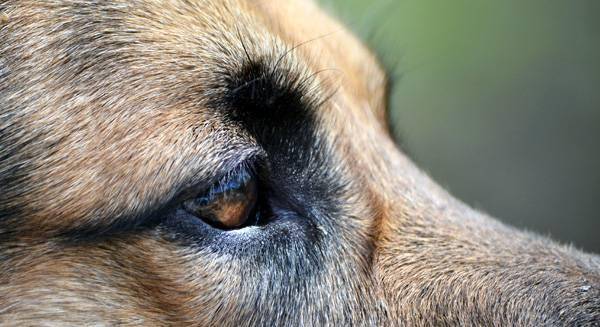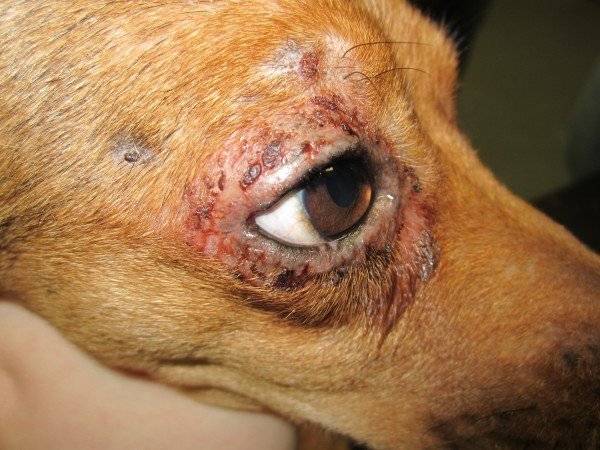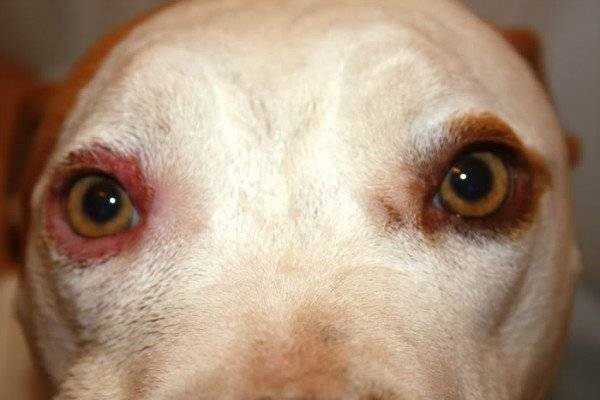There are many dog diseases that owners can and do not suspect until the disease develops and manifests itself in the form serious symptoms. Most of these diseases also apply. pathologies regarding the organs of vision of the animal. What diseases dogs should pay attention as early as possible to know that the dog is not healthy? After all, early diagnosis allows you to timely heal a pet before it appears complications.

Content
- 1. Blepharospasm: symptoms and treatment
- 2. Prolapse of the third century: symptoms and treatment
- 3. Clinical manifestations and therapy of dermatitis of the eyelid in dogs
- 4. Symptoms and treatment of conjunctivitis
- 5. Ectropion and entropion: symptoms and treatment
- 6. How blepharitis manifests itself and is treated
Blepharospasm: symptoms and treatment
Contents
If the pet starts blinking quickly and without stopping, then this a sure sign of blepharospasm – accelerated and unconscious muscle contraction of the eyelids. In addition, the following symptoms:
- the eye and the area around it may swell;
- palpation causes pain;
- the pet has photophobia, that is, he avoids watching to the light;
- inflammatory fluid is exuded from the eyes – exudate.
In itself, this pathological condition is not dangerous, but it the manifestation should alert the owner, since blepharospasm is not an independent disease, but only a symptom of developing the body’s inflammatory or infectious processes of the eyes, for example, inflammation of the trigeminal nerve.
There is no separate treatment for blepharospasm, as it disappears only after the elimination of the root cause, that is, the cure for the disease that caused this condition.
Special drugs are used for pain relief, used in ophthalmology, for example, Ledocaine. Without certain skills such tools can not be used! Most of them, due to the high content of toxins, it is used only in this areas and with the wrong dosage can poison the pet.

Prolapse of the third century: symptoms and treatment
This ailment has another name – “cherry eye”, it due to the fact that the eyeball really becomes like on a ripe cherry berry. With this pathology, the third eyelid of the dog leaves its usual place and is in the corner of the eye. IN in most cases, only one eye is affected, but it also occurs bilateral prolapse.
Modern medicine has not yet fully figured out the reasons for this. conditions, but most often the third eyelid goes off due to weakness tissues holding it. There are breeds of dogs that have this congenital condition and all representatives are prone to the manifestation of the “cherry eye”. These include: bulldogs, english cocker spaniels, hounds.
Studies have shown that a disease can wear hereditary character. If the parents have dogs, or at least one of them, there is a disposition to this pathology, then in In subsequent generations, it will certainly manifest itself. If at acquiring a pet a similar diagnosis is recorded on the card, then from purchases are best refused.
The disease does not threaten the life of the animal, but there are several negative points:
- the pet’s appearance deteriorates;
- dogs with this disease are not the best option for breeding;
- prolapse affects the activity of the lacrimal glands, which provokes frequent inflammatory processes of the conjunctiva (conjunctivitis) and cornea of the eye (keratitis).
Definitely, this disease requires timely treatment and more often In total, it consists in surgical intervention. It’s connected with by the fact that once it falls out, the eyelid will constantly leave its a place.
The operation itself is not complicated, but leads to a violation functions of the lacrimal gland. The pet owner needs a lifetime will carry out maintenance therapy – apply eye drops or saline to moisturize the mucous membranes of the eyeball.

Clinical manifestations and therapy of eyelid dermatitis in dogs
This ailment can not be called an eye disease, but pathology often develops into an eye disease. Among the main features the following can be noted:
- an inflammatory process develops on the skin of the eyelid, they Blush
- wet areas appear;
- pus may appear;
- an unpleasant nauseating smell emanates from the dog;
- eyes turn sour;
- exudate (inflammatory fluid) is released from the eyes.
In such states, it is quite logical that over time pathogens spread to the conjunctiva. More often In total, this disease is diagnosed in pets with long hair and hanging ears.
As treatment, antibiotic drugs are used, with a wide spectrum of action. Wool from affected areas must be cut, a special ointment with antiseptic effect. In the eyes you need to instill drugs antimicrobial action, before that it is advisable to wash them saline, always sterile.
In order to exclude combing of sick eyelids with a pet, a medical collar is used.

Conjunctivitis in dogs
Symptoms and treatment of conjunctivitis
Conjunctival inflammation is the most common eye disease, both in humans and in animals, which in In most cases, it is infectious. Besides, the causes of the disease can be:
- viruses
- allergic reaction;
- inflammatory process in the lacrimal ducts or their blockage (in in this case, the conjunctiva is left without the necessary hydration);
- hit in the eye of a foreign object;
- irritant substances that have penetrated the conjunctival region cavities;
- irritation due to inversion of the eyelid (eyelashes damage the eye tissue);
- mycoses.
The clinical picture is as follows:
- mucous membranes of the eyes become pink or red;
- eye and eyelid tissues may swell;
- discharge appears from the eyes – it may be transparent lacrimal fluid, watery exudate or purulent clots;
- part of the third century may appear in the inner corner of the eye – to owners of the dog who do not have experience, it may seem that this eye rolled out.
The pet may have strabismus or constant blinking. The last sign may be painful, the dog in this case will be restless, often rubbing his eyes and whining mournfully.
Often conjunctivitis accompanies the same symptom as with keratitis – clouding of the cornea of the eye.
If we talk about the treatment of the disease, then it depends on the cause the occurrence of conjunctival inflammation. Most often, therapy includes the use of antibacterial drugs – drops, ointments and other forms of drugs. Among the external medicines itself tetracycline ointment is popular.
But before prescribing treatment, the veterinarian must conduct thorough diagnostics, study analyzes, and only after receiving the results to resolve the issue with therapy.

Ectropion in dogs
Ectropion and entropion: symptoms and treatment
In simple terms, we are talking about eversion and inversion century in dogs. These pathologies can be called true canine. ailments, as in other animals they are diagnosed extremely rarely.
Diseases are hereditary, and especially to them Representatives of the following breeds are located – Staffordshire terriers, basset hounds, sharpei, dogs, ridgebacks, dachshunds, chow chow, Newfoundlands, some types of spaniels, St. Bernards.
When considering these ailments (inversion and eversion), they can combine, as often they have a parallel development. Of course, inversion of the eyelids leads to more serious consequences, however, their eversion leaves the eyeball without any protection against pathogenic pathogens.
In addition to pathological changes in the appearance of the eyes, these diseases accompanied by the release of fluid, constant blinking, with when pressed, the animal feels pain.
With ectropion, the conjunctiva loses moisture and dries, which may cause keratitis and other severe violations.
Sometimes inversion of the eyelids leads to the growth of eyelashes in the eye tissue and this disease is already considered an independent disease.
Treatment of eversion and inversion of the eyelids is most often carried out surgically, and it can only be done in adults individuals whose growth has stopped. Conservative therapy has a place to be, but only if the pathology is in the initial stage development.
To eliminate the symptoms and causes of the disease, apply antibacterial agents, antiseptics, hormone therapy and others medicines.

Dog blepharitis
How is blepharitis manifested and treated
This disease is an inflammation of the eyelids, both skin and subcutaneous layers. The causes of the disease include infections, hereditary predisposition, allergens, injuries eye.
The signs of blepharitis are obvious – the eyelids swell, redden, may purulent formations appear, which are then covered scabies.
The disease requires emergency treatment, as it is often combined with other pathological conditions of the eyes. Therapy depends on the cause of the inflammation – sometimes antibiotics are prescribed, preparations against microbes, antiallergic drugs.
Any eye diseases in dogs should be diagnosed by early stages of development and timely treatment, in avoidance of serious and severe complications.






